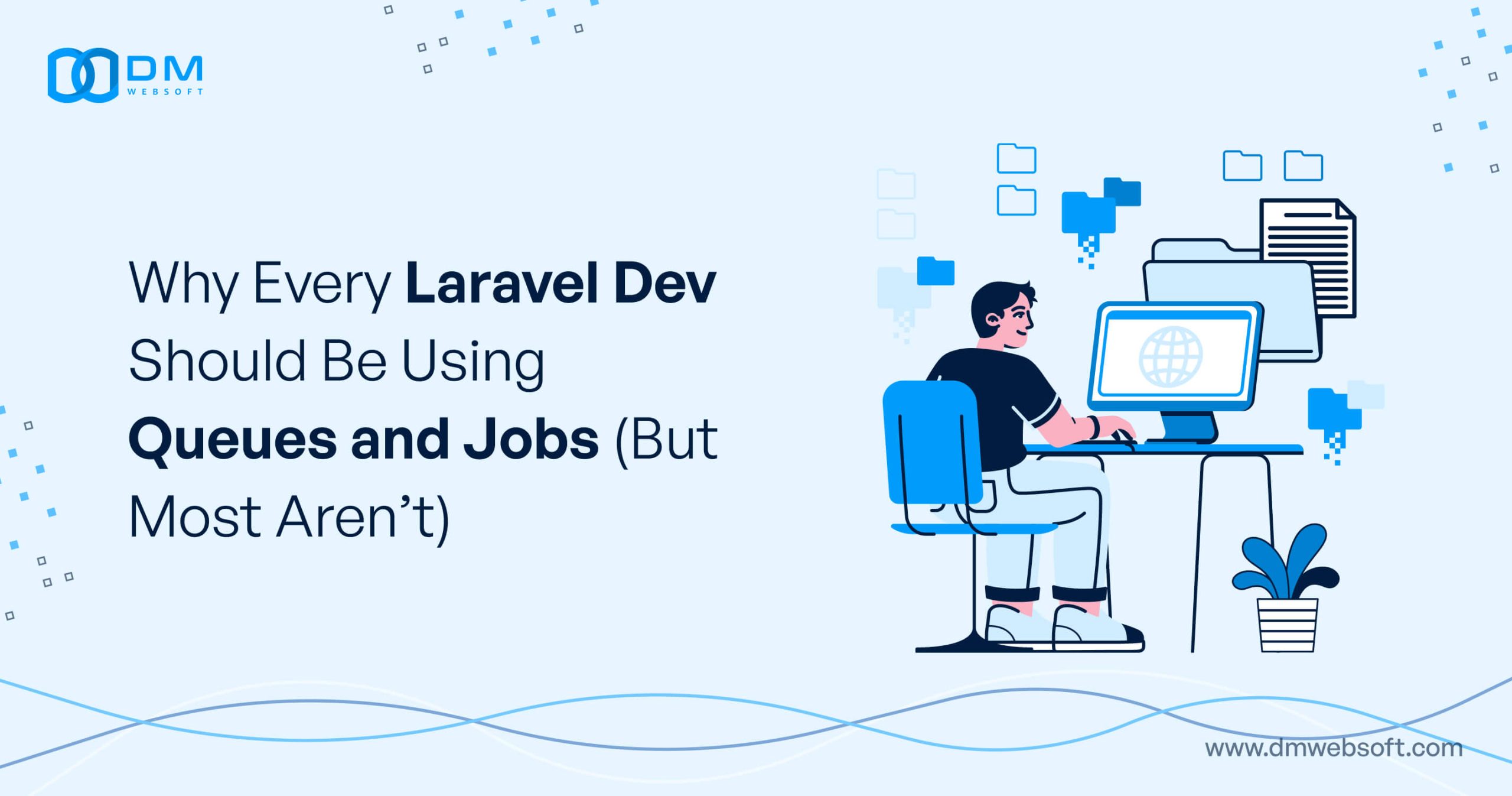DM WebSoft LLP exceeded our expectations! Their seasoned team of experts delivered a website that perfectly captures our brand essence. Their 15+ years of experience truly shine through in their exceptional web development skills.
Creating Scalable Mobile App Architectures: Insights for Entrepreneurs

TABLE OF CONTENT
Get in Touch
Introduction

In today’s digital world, mobile app scalability is a necessity and not a luxury for any business that seeks to thrive. It doesn’t matter whether you’re a startup or an established enterprise; ensuring that your mobile app can handle increasing loads of user demands and keep up with performance is critically essential. But what really powers this capability and ensures your app continues to grow smoothly, without hurting either efficiency or user satisfaction, is a scalable mobile app architecture.
How a mobile application can actually scale well starts with well-thought planning and strategic implementation. It is about designing an architecture that will support the current needs of an app together with the growth it might have in the future. This premonition will make the application strong, responsive, and reliable even in case of large user adoption. Here at DM WebSoft LLP, we understand the complications to build scalable mobile apps, which is why we go a long way to help entrepreneurs implement their vision through our expert development services.
Some basic components of a scalable mobile app architecture are layered architecture, microservices, asynchronous processing, caching mechanisms, and database optimization. Each of these factors is important in ensuring that the app supports high traffic while at the same time handling a large volume of data without any performance issues. Implementation of best practices in this regard will make any business application more efficient, reliable, and future-proof.
Scalability means much more than simply handling more users; it also maintains performance, security, and maintainability of the software as the user base grows. Efficient scaling within your app can help avoid common pitfalls such as slow load times, server crashes, and security vulnerabilities, which would affect your reputation and the trust of your user.
At DM WebSoft LLP, we concentrate on creating scalable app infrastructures adapted to each business requirement. Our experts use modern technologies and industry best practices to design and develop mobile apps that can be scaled. When partnering with us, entrepreneurs can keep their focus on core business functions while we take care of the complexity of building scalable mobile applications.
In this blog, we are going to look at some essential principles of designing scalable mobile apps, common challenges and their solutions, and real-life examples of successful scalable architectures.
Whether you’re new to this or you want to make sure your already developed app is top-notch, this complete guide will help you with all the tips and insights that will ensure your app’s success.
Scalable Mobile App Architecture: Understanding

The true understanding of scalable mobile app architecture has to go hand in hand with what comprises it and why it really matters. It is architecture that supports growth in user base and data volume without affecting performance. It actually means that if there is an increase in the demand for the app, its efficiency, as well as the user experience, remains consistent.
Scalable Architecture
- Layered Architecture: The layered architecture is where the app is broken down into distinct layers, and each of the layers has some special work to do with the application.
- There are three main primary layers: Presentation Layer: It’s the layer responsible for all user interface and user experience parts of the application. This layer is core to having a smooth and intuitive interaction from the user’s perspective.
- Business Logic Layer: It is the section that dictates the core functionalities of an app or system, like computations, validations, and analytics. It processes data and determines how it should interact with other parts of the system.
- Data Access Layer: Interfaces with databases and storage systems to fetch and store data. The layer is an abstraction for physical storage so that business logic can work without caring for the database specifics.
- Microservices Architecture: Unlike monolithic architectures, microservices divide the app into smaller, independent services that can be developed, deployed, and scaled separately. Every service performs a particular function and has interaction with the other using APIs. It’s more flexible and scalable, and one can upgrade or scale individual components without affecting the whole system.
- Asynchronous Processing: Offloading non-critical tasks to the background ensures that the app is more responsive. Perform tasks such as data synchronization, notifications, and other long-running operations asynchronously—all this so that the app continues to be responsive while a user interacts with it.
- Caching Mechanisms: Most probably, your application will benefit from using content delivery networks to cut down on the duration of loading time and server pressure through the application of caching strategies. Caching stores often-accessed data close to the user, reducing the number of subsequent database queries and thus increasing overall app performance.
- Database Optimization: The right selection of the database type, for example, NoSQL for unstructured data, along with techniques such as sharding and partitioning, is what is used to manage huge volumes of data. Optimization on the database includes both its queries and indexes, reducing execution times and increasing retrieval speeds.
Why It Matters
A well-designed, scalable infrastructure of an application ensures that your app doesn’t crash under heavy traffic and data but continues to perform normally. It is very important for businesses that expect fast growth or have varying patterns of usage. In this way, scalability complements operational efficiency with user satisfaction and retention by delivering smooth experiences even under high demand.
At DM WebSoft LLP, we develop mobile app architectures that are scalable based on business requirements. Our expertise assures your application remains robust, efficient, and capable of growing with your user base. You can leverage this collaboration to refocus on key business activities while we manage the complexities involved in building and maintaining a scalable app.
Scalable Mobile App Design Principles

The key principles of designing a scalable mobile app include certain decisions that ensure the app is able to scale more easily and effectively, all the while keeping performance and user satisfaction high. Let’s discuss these in some detail.
Layered Architecture
Layers of architecture keep the application organized at multiple levels, so it is kept manageable and each layer is responsible for a separate purpose within the application. This approach encourages modularity and maintainability, allowing for the possibility of scalability of individual elements without impacting the whole system.
- Presentation Layer: It represents an interface and the user experience, which assures a great and clear interaction for a user. It would contain interfaces, components, data formatting, and device adaptation.
- Business Logic Layer: It involves the events and operations happening between business entities. It is considered to be the most important layer as it contains the real functionality of the application and its rules: computations, manipulating data, and business workflows. It manipulates the data sent from the presentation layer and maintains interaction with the data access layer.
- Data Access Layer: This interfaces databases and storage systems for the retrieval and storage of information. It abstracts the inner workings of data storage, letting the business logic work without bothering about database specifics.
- Microservices Architecture: microservices architecture decomposes the application into small, independently deployable services that scale independently. Each microservice implements a specific function and interacts with other services through APIs.
- Independence: Microservices are updated, scaled, and deployed independently; this increases flexibility and reduces the risk of system-wide failures.
- Scalability: Each service has the ability to scale as necessary to ensure effective use of resources and optimization of performance.
Asynchronous Processing
An implementation that supports asynchronous processing allows the system to delegate background operations, which are not critical, to optimize responsiveness and user experience. This means data synchronization, notifications, and background processes can be handled as separate back-end tasks that take place asynchronously, while the main application layer remains responsive to user interactions.
Caching Mechanisms
Caching mechanisms play an important role in performance and scalability. Caching keeps frequently accessed data closer to the application layer, which not only minimizes repeated database access but also speeds up load times.
- CDNs: CDNs cache static assets such as images, videos, and stylesheets at several geographical locations, in turn lowering latency and reducing load time for users from different regions.
- Local Caching: Local caching strategies, when used within your application, have an exponential effect on the increase in performance because the data, which often has high access frequency, is situated directly on the device.
Database Optimization
This has to do with choosing the right kind of database and techniques that efficiently handle big data. It includes:
- Choosing the Right Database: NoSQL databases, including MongoDB and Cassandra, are scalable and can offer a mechanism for storing unstructured data. Accordingly, they are highly useful with large-scale applications.
- Sharding and Partitioning: This divides the database into smaller parts or portions, hence making the whole database manageable, hence an efficient way of getting and updating data.
- Index Optimization: Efficient query execution time is reduced very much when the database is indexed properly, and therefore, performance improves exponentially.
- Scalability for High Performance: It’s important to make the development of a mobile app scalable for high performance, security, and user satisfaction in using an increased app.
This guarantees operating efficiency without falling into common traps such as slow load times, server crashing, and security issues.
At DM WebSoft LLP, we strive for scalable app architecture to fulfill your business needs. Our experts make use of advanced technologies and adopt best industry practices in developing scalable mobile apps.
Strategies for Ensuring Scalability

Scalability can be done once you design your mobile app to handle the incoming loads and still perform in peak performance. Based on this, below are some key strategies for scalability:
Horizontal and Vertical Scaling
- Horizontal Scaling: This is a method where servers or nodes can be increased so that there can be a distribution of the workload evenly. Horizontal scaling augments the capacity of a system to handle incoming requests concurrently by spreading the load. This is more useful for applications having unpredictable traffic, including quickly growing ones.
- Vertical Scaling: Increasing capacity by boosting resources such as CPU, memory, or storage is one way to go about this. While vertical scaling may in point of fact provide increasing performance, it is constrained by hardware capacity and can become prohibitively expensive as a solution.
In fact, both methods can be combined into what is referred to as diagonal scaling, which further aids in utilizing the strengths of each method toward optimal performance and cost efficiency.
Load Balancing
Load balancing is undertaken to assure that incoming traffic is distributed evenly among multiple servers and not dumped on one.This way, the app is always responsive and performing at its best, no matter how many visitors are there.
Some of the algorithms that can be used to balance the load include Round Robin, Least Connections, and IP Hash. Moreover, advanced load balancers are smarter in their operations; they further take into account server health and capacity for better efficiency in the setup.
Benefits: Load balancing enables better usage of resources, enhances fault tolerance, and ensures high availability through the proper direction of flows to healthy servers, as compared to those which are over-flooded with requests.
Cloud Services and Auto-Scaling
Using cloud services is one of the important ways to achieve the desired goal of scalability. AWS, Azure, and Google Cloud are some important cloud platforms that have come up with a variety of tools and services oriented toward supporting scalable architectures.
- Auto-Scaling: Cloud services are always included with the feature of auto-scaling, which helps adjust the resources as per the real-time demand coming in. This assures that your app gets resources when they peak out for handling loads and scales down to save the cost during the idle period.
- Elasticity: Cloud platforms provide a resource scaling feature that ensures resources are increased or decreased such that they are of sufficient quantity for optimized performance without overprovisioning.Dynamic allocation is critical to maintaining responsiveness and efficiency in applications.
Caching and Content Delivery Networks (CDNs)
A type of caching with CDNs helps improve performance and scalability for an application by decreasing server load and delivery time.
Caching: Implementation of caching strategies means that frequently accessed data should reside close to the application layer, thereby reducing database queries and its loading time. Another significant help to performance from local caching with an app is the ability to cache data on a user’s device. CDNs are used to distribute static content, such as images, videos, and stylesheets, to a number of geographically dispersed locations. This helps in reducing latency and improving the load times for the users, since the content is served from the nearest CDN node.
Monitoring and Optimization
Continuous monitoring and optimization is one of the most important activities for sustaining and enhancing scalability. By monitoring key performance metrics, you can identify and mitigate potential bottlenecks before they affect the user experience.
- Monitoring Tools: Real-time insights into resource utilization, performance, and the health of your application are provided by tools such as AWS CloudWatch, Azure Monitor, and Google Cloud Monitoring. These tools further assist in proactive issue resolution and the fine-tuning of performance.
- Optimization Techniques: Continuous optimization of database queries, server configurations, and code can drastically improve performance and scalability. This may include the optimization of caching strategies, load balancing configurations, and ensuring efficient resource utilization.
DM WebSoft LLP implements these strategies in the designing and development of scalable mobile applications. We can ensure that your app is robust and responsive, ready to cope with increasing demands by users in the best way possible.
Challenges and Solutions

There come a few challenges when it comes to building scalable mobile applications. Overcoming them is the key to ensuring an application scales properly and remains reliable. Here are some of the most common problems and corresponding solutions:
Load Balancing
The major challenge that one meets with while shaping the architecture of scalable mobile app development is maintaining a proper traffic distribution over the servers. Consequently, certain servers become overloaded, whereas most of the other servers remain idle.
Solution: This issue can be solved through load balancing. Load balancers distribute the load across various servers, with algorithms such as round-robin, least connections, or IP hash. Modern load balancers can even gauge server health and determine traffic based on server capacity, so that the use of resources is optimized.
Network Fluctuation Management
Mobile networks are unpredictable, and the signal strength and stability of a device can easily affect the app’s performance. However, ensuring the performance of applications under different conditions of network operation has been quite a challenge.
This means that this should be accounted for in the application design by handling these fluctuating network conditions. Adaptive streaming, data compression, and offline capabilities are just a few techniques ensuring ways to maintain performance. This can be optimized using lightweight data formats and data transfer protocols to minimize the impact of network fluctuations.
Ensuring Security
With a growing app, providing an adequate level of security to keep user data safe and secure without any breach is quite challenging. Security issues may arise from many sources, such as the transmission or storage of data and user authentication.
Solution: Implementation of strict security protocols, which includes encryption both at rest and in transit, strong authentication mechanisms, secure coding techniques, and continuous security audits. It’s built to comply with industry standards and regulations like GDPR and HIPAA for better application security.
Maintaining Code Quality
As the app scales and you keep adding more features, it becomes tough to maintain top-notch code quality. Poor quality code can be a source of bugs and performance problems, driving up maintenance costs.
Solution: Adhere to good code quality practices—examples include clean and modular coding, with the principles of DRY—Don’t Repeat Yourself and SOLID—Single Responsibility, Open-Closed, Liskov Substitution, Interface Segregation, and Dependency Inversion. Implement regular code reviews, automated testing, and CI/CD pipelines to ensure the quality of the code remains high and the development process is smooth.
Optimal Performance
Ensuring the app works well under increasing loads is quite a challenge. Performance bottlenecks can come from many different things: inefficient database queries, slow server responses, or resource-intensive processes.
Solution: Regular monitoring and optimization related to refining database queries and indexes, bettering caching strategies, and ensuring efficient use of server resources. Real-time performance metrics can be viewed through monitoring tools such as AWS CloudWatch, Azure Monitor, and Google Cloud Monitoring to identify and proactively resolve any possible bottlenecks.
At DM WebSoft LLP, we are fully equipped for these challenges with our knowledge in creating scalable mobile applications. We adhere to industrial standards with cutting-edge technologies that keep your app solid, secure, and performant. Partnering with us will allow you to focus on your core business while we take care of the technical complexities.
Real-life Examples of Scalable Mobile App Architectures

Understanding how leading mobile apps achieved scalability can provide highly useful insights into the best practices and strategies for building a highly robust, scalable solution. Here we describe real-life examples of successful scalable mobile apps and lessons learned during their development.
WhatsApp is one of the best examples of a mobile application that has scaled well with a vast number of users. More than 2 billion users require an architecture that can easily handle billions of messages, calls, and media files each day.
Major Strategies:
- Layered Architecture: The architecture WhatsApp adopted is layered, separating the UI, business logic, and data access layers, which allows scaling and maintaining individual modules easily.
- Asynchronous Processing: WhatsApp uses an Asynchronous Processing model for certain things—like message delivery and notifications—in order to make the app remain responsive under high load.
- Database optimization: Uses a combination of relational and NoSQL databases that manage tremendous volumes of data in the most efficient way, with techniques like sharding used in distributing the load across them.
Uber
Uber has truly disrupted the transport business with a scalable mobile application architecture, offering millions of rides per day.
Strategy:
- Microservices Architecture: The microservices architecture breaks down the app into small, independent services that are developed, deployed, and scaled independently. This approach raises flexibility and allows Uber to scale out only the particular features that it might require.
- Load Balancing and Auto-Scaling: Uber makes the use of the most recent technology in the area of load balancing and auto-scaling to ensure that traffic is managed properly. With cloud services, Uber can dynamically distribute resources depending on demand at any given time.
- Real-Time Data Processing: The system processes data in real time to deliver the right ETAs, dynamic prices, and optimized routes in order to ensure the best customer experience.
Netflix
It streams billions of hours of content monthly, making it a good example of an application that has scaled to the needs of its global audience.
Key Strategies:
- Cloud Services: The use of AWS cloud services by Netflix is for high scalability and availability. For Netflix, cloud infrastructure has provided dynamic handling of changes in demand through time; there are regular surges during peak times, which come with every new movie or show release.
- Content Delivery Networks (CDNs): The main use of CDNs by Netflix is to provide quick and reliable delivery of content throughout the world, which assures that user experience will be low in terms of latency.
- Data Analytics and Optimization: Netflix deals with enormous data analytics to optimize content recommendations for better user engagements and effective resource handling.
Lessons Learned
What has been learned from the examples above may provide some of the key lessons in building a scalable mobile app:
- Modularity and independence: Divide the application into modular components through layered architecture or microservices, making scaling easier and offering easier maintenance.
- Efficient Data Management: Optimizing databases with techniques like sharding and caching are critical features for managing large volumes of data.
- Dynamic Resource Allocation: By making use of cloud services to balance loads and having the ability to auto-scale, resources are highly used, thus putting the app in a responsive state whenever the loads change.
- Monitoring and Optimization: Periodic monitoring of performance metrics and optimization of the various components of the app help proactively identify and alleviate bottleneck situations.
At DM WebSoft LLP, we apply these proven strategies to help businesses build scalable mobile apps tailored to their unique needs. With our experience in scalable architecture design, your app should be able to grow effortlessly and sustain an optimized performance level under any condition.
Mobile App Development With Scalability in Mind

DM WebSoft LLP understands the complex structures of mobile app development and possible hurdles in creating scalable mobile app architectures. Our team, full of dedicated experts in the field, uses industry best practices together with the latest technology to design and develop mobile apps that grow in parallel with your business. Here’s how we can help you build scalable mobile applications:
Custom Architecture Design
No two businesses are alike, and this is where, at DM WebSoft LLP, we have specialized in the implementation of custom scalable app infrastructures according to your business needs.
Tailored Solutions
It all starts with a comprehensive examination of your business needs, goals, and technical demands. That insight goes into producing architecture that’s custom, scalable, reliable, and on-point for performance.
Layered and Microservices Architectures
Based on your requirements, we engineer either a layered architecture to assure the highest level of modularity and separation of concerns or a microservices architecture that provides the greatest level of flexibility and independent scalability of different app components.
Performance Optimization
Attaining optimal performance is the underlying principle of achieving user satisfaction and operational efficiency. Below is the list of fallbacks our team will apply to squeeze the best out of your mobile app:
- Asynchronous Processing and Caching: We bring in asynchronous processing for non-critical paths to ensure that nothing blocks us from being responsive. We use CDNs and caching to hold often-fetched data closer to users, save time, and reduce demand on our server.
- Load Balancing and Auto-Scaling: Advanced techniques used in load balancing strategies will ensure that an efficient cloud service is best utilized by your application for variable workloads. Our auto-scaling solutions dynamically adjust resources based on real-time demand, ensuring optimal performance during peak usage times.
Conclusion

It is arguably the most important point for a scalable mobile app architecture toward the success and growth of a particular business in this competitive digital world. Scalability means that your app can handle increasing loads, retain optimum performance, and keep providing a seamless user experience even as the user base grows. Key enablers to this are core principles like layered architecture, microservices, asynchronous processing, caching mechanisms, and database optimization that businesses are able to use to build effective and strong mobile apps.
In the course of building scalable apps, therefore, there exist several challenges, among them being the capability of balancing out the distribution of loads, variations in network, security, and quality of code. The effectiveness of these strategies and best practices for scalability can be demonstrated by the real-life examples from industry leaders like WhatsApp, Uber, and Netflix.
DM WebSoft LLP focuses on supporting entrepreneurs and businesses to build mobile scalable apps. Our comprehensive services include custom architecture design, performance optimization, database management, robust security measures, and continuous support and maintenance. Scale your business and drive value. Focus on core business activities as we take care of the technical complexities with respect to app development and scalability.
You are welcome to explore scalable mobile app architecture with DM WebSoft LLP. Our team of experts will help build an app for your current requirements but also aligned with future growth. Contact us today to learn more about how we can assist in creating a mobile app that is scalable, high-performing, and drives your business forward.
Scalable mobile app architecture is designed to handle increased loads and user demands efficiently as the app grows.
Scalability ensures that mobile apps maintain optimal performance and user experience even as their user base expands.
Key components include layered architecture, microservices, asynchronous processing, caching mechanisms, and database optimization.
DM WebSoft LLP provides custom architecture design, performance optimization, database management, robust security measures, and continuous support.
Strategies include horizontal and vertical scaling, load balancing, cloud services, auto-scaling, and efficient data management.
Get Started Now !
What’s the Process ?
Request a Call
Consultation Meeting
Crafting a Tailored Proposal
Get Started Now !
Real Stories, Real Results. Discover What Our Clients Say

Working with DM WebSoft LLP was a game-changer for our business. Their technical prowess and innovative solutions transformed our online presence. A highly recommended web development agency with a stellar track record.

We are thrilled with the results DM WebSoft LLP delivered. Their deep understanding of web development coupled with years of expertise ensured a seamless and visually stunning website. True professionals!

In a digital age where first impressions matter, DM WebSoft LLP crafted a website that speaks volumes. The team’s attention to detail and commitment to quality set them apart. Thank you for making our vision a reality.

DM WebSoft LLP’s team demonstrated unparalleled expertise. Their ability to navigate complex technical challenges with ease is truly commendable. Choosing them for our web development needs was the best decision.

Exceptional service, unmatched skills! DM WebSoft LLP stands out as a leading web development agency. Their collaborative approach and commitment to excellence make them our go-to partner for all things web-related.

DM WebSoft LLP turned our ideas into a digital masterpiece. The seamless communication and timely delivery of our project showcased their professionalism. Highly impressed with the level of creativity and skill.

Our experience with DM WebSoft LLP was nothing short of amazing. From concept to execution, their team provided top-notch web development services. A reliable partner for businesses looking to elevate their online presence.

DM WebSoft LLP’s team of tech experts is second to none. Their wealth of experience reflects in the quality of their work. Our website not only meets but exceeds industry standards, thanks to their dedication.

Choosing DM WebSoft LLP was the best investment for our web development needs. Their team’s proficiency, coupled with a customer-centric approach, made the entire process smooth and enjoyable. A pleasure to work with!





